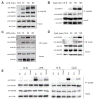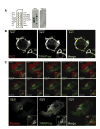A promiscuous lipid-binding protein diversifies the subcellular sites of toll-like receptor signal transduction
- PMID: 24529375
- PMCID: PMC3951743
- DOI: 10.1016/j.cell.2014.01.019
A promiscuous lipid-binding protein diversifies the subcellular sites of toll-like receptor signal transduction
Abstract
The Toll-like receptors (TLRs) of the innate immune system are unusual in that individual family members are located on different organelles, yet most activate a common signaling pathway important for host defense. It remains unclear how this common signaling pathway can be activated from multiple subcellular locations. Here, we report that, in response to natural activators of innate immunity, the sorting adaptor TIRAP regulates TLR signaling from the plasma membrane and endosomes. TLR signaling from both locations triggers the TIRAP-dependent assembly of the myddosome, a protein complex that controls proinflammatory cytokine expression. The actions of TIRAP depend on the promiscuity of its phosphoinositide-binding domain. Different lipid targets of this domain direct TIRAP to different organelles, allowing it to survey multiple compartments for the presence of activated TLRs. These data establish how promiscuity, rather than specificity, can be a beneficial means of diversifying the subcellular sites of innate immune signal transduction.
Copyright © 2014 Elsevier Inc. All rights reserved.
Figures





Comment in
-
Innate immune signalling: TIRAP diversifies the sites of TLR signalling.Nat Rev Immunol. 2014 Apr;14(4):211. doi: 10.1038/nri3645. Epub 2014 Mar 7. Nat Rev Immunol. 2014. PMID: 24603164 No abstract available.
-
Promiscuity is not always bad.Mol Cell. 2014 Apr 24;54(2):208-9. doi: 10.1016/j.molcel.2014.04.009. Mol Cell. 2014. PMID: 24766883 Free PMC article.
References
-
- Akira S, Uematsu S, Takeuchi O. Pathogen recognition and innate immunity. Cell. 2006;124:783–801. - PubMed
-
- Aksoy E, Taboubi S, Torres D, Delbauve S, Hachani A, Whitehead MA, Pearce WP, Berenjeno-Martin I, Nock G, Filloux A, et al. The p110delta isoform of the kinase PI(3)K controls the subcellular compartmentalization of TLR4 signaling and protects from endotoxic shock. Nat Immunol. 2012;13:1045–1054. - PMC - PubMed
-
- Baeuerle PA, Baltimore D. Activation of DNA-binding activity in an apparently cytoplasmic precursor of the NF-kappa B transcription factor. Cell. 1988;53:211–217. - PubMed
-
- Barbalat R, Ewald SE, Mouchess ML, Barton GM. Nucleic acid recognition by the innate immune system. Annu Rev Immunol. 2011;29:185–214. - PubMed
Publication types
MeSH terms
Substances
Associated data
- Actions
Grants and funding
- R01 AI093589/AI/NIAID NIH HHS/United States
- AI064705/AI/NIAID NIH HHS/United States
- R01 AI063106/AI/NIAID NIH HHS/United States
- P30 DK034854/DK/NIDDK NIH HHS/United States
- R01 AI106934/AI/NIAID NIH HHS/United States
- AI072955/AI/NIAID NIH HHS/United States
- R56 AI093589/AI/NIAID NIH HHS/United States
- AI063106/AI/NIAID NIH HHS/United States
- R01 AI064705/AI/NIAID NIH HHS/United States
- P30DK34854/DK/NIDDK NIH HHS/United States
- R56 AI103082/AI/NIAID NIH HHS/United States
- K99 AI072955/AI/NIAID NIH HHS/United States
- T32 DK007477/DK/NIDDK NIH HHS/United States
- AI093589/AI/NIAID NIH HHS/United States
- R00 AI072955/AI/NIAID NIH HHS/United States
LinkOut - more resources
Full Text Sources
Other Literature Sources
Molecular Biology Databases
Research Materials

